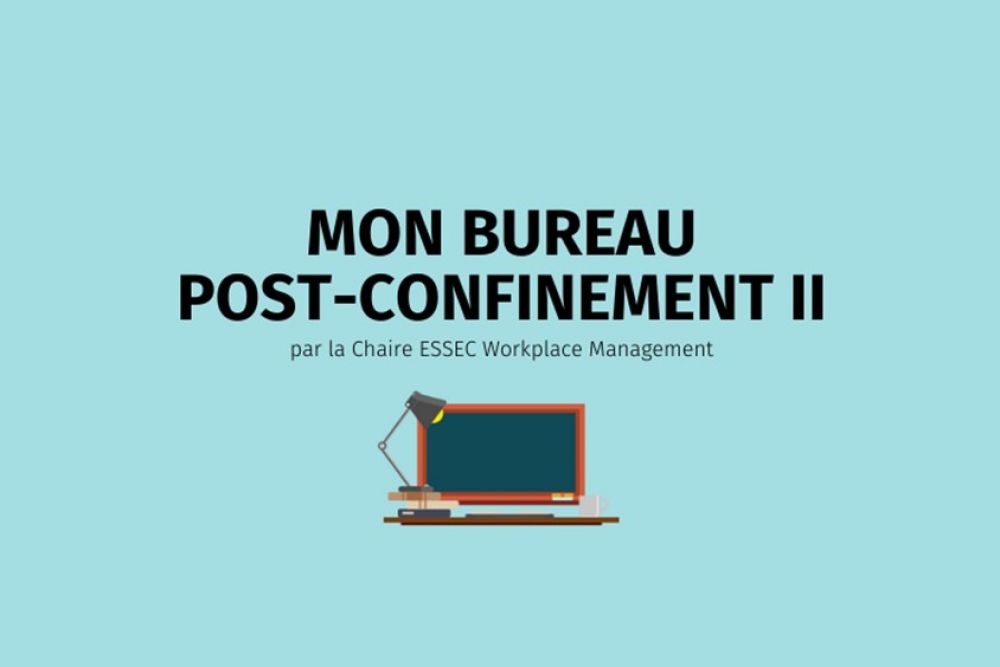- Home
- EN
- Kardham Group
- News
Workplace Management Chair: the post-lockdown office is redefining itself
October 2020

A study My post-lockdown office II of the Workplace Management Chair of ESSEC Business School.
Cergy, October 14, 2020 - Carried out by the Workplace Management Chair of ESSEC Business School under the supervision of Professor Ingrid NAPPI, this academic research reveals the way in which office workers understand their workspaces four months after the deconfinement in time of the Covid-19 health crisis: what are their expectations regarding the types of workspace desired, what impacts on the post-containment office, but also what ideal working mode in the tertiary space.
Carried out on the basis of an online survey conducted from September 7 to 20, 2020*, the originality of the study conducted by the university researchers of the research chair is to identify statistically significant associations between certain categories of membership respondents and their choice of workspaces best suited to their needs, both in terms of working style and physical space (Chi-square test and Z test for proportions).
This survey also studies for the first time and in a rigorous way the ideal distribution of working time between work in a company, at home and in third places. Finally, the study also looks at the statistically significant link between the desire or not to move following confinement and the possibility of working remotely.
The major lessons that emerge from our survey:
A preference for low-density workspaces
Already during the first edition of the survey in April 2020, this trend was felt with 68% of preferences expressed for this type of space: thus, we had recorded 33% of preference for the individual office, 10% for the shared office and 25% for teleworking.
In September 2020, this trend is clearly confirmed since we find 40% preference for the individual office, 21% for the shared office and 19% for teleworking. We are now moving to 80% preference for spaces with a low density of people.
Post-containment and in times of health crisis, office workers therefore prefer to work in a space with few people.
The post-lockdown workplace...
Ideally, respondents want to spend 55% of their working time in a company, 37% of the working time at home, 6% of the working time in third places and the remaining 2% of the time in other places.
Contrary to popular belief and despite the fact that the majority of respondents wish to continue the experience of teleworking, working in the office or in a company has therefore not had its last word. In addition, it turns out that third places now seem to be very unpopular with office workers.
... in a company, at home or in third places: the preference depends on the category to which the respondents belong
- In a company
In fact, we see, for example, that the professional status of respondents influences the choice of the proportion of working time they wish to spend in a company.
Thus, civil servants are those who wish to spend the most time in a company (64% of their working time).
The socio-professional category also has an impact: senior executives are those who wish to work the least of their working time in a company. On average, 45% of their working time against 56% for employees and 52% for executives (significant difference).
The type of usual workspace also has its role to play: we indeed observe that those who work in individual or shared offices (less than 6 people) are those who want to spend most of their working time in a company (difference significant). Respectively, in the ideal distribution 61% and 58% of their working time.
- At home
Here, it is the self-employed who want to spend most of their working time at home (45% of the time), while company employees only see themselves there for 40% of their time and civil servants 29 %.
In addition, it is those used to working mainly in flex-office and open space who would work the most from their home (42% of working time) while those who work in individual and shared offices want to work there for 32%. % and 35% of their time.
- In third places
Third places, although not very popular, take the preferences of self-employed workers since they spend 14% of their time there (unlike company employees [6% of the time] and civil servants [4% of the time ]); senior executives who devote 10% of their time to it compared to 6% of the time for executives and employees; and flex-office users who want to work there 10% of their time compared to around 5% for those who work in closed (individual and shared) and open space offices.
In short, four months after the deconfinement, office workers returned to work in the office while alternating with a few days of telework per week.
Third places, which were growing rapidly before containment, have lost their appeal, probably related to the fact that office workers now mostly want to work in spaces with a low density of people (individual office, shared office or teleworking) ).
However, they won the favor of certain categories of respondents who expressed the wish to spend most of their working time there.
Moreover, we note that the desire to work mainly in a business, at home or in third places depends on the category of the respondents.
A word from Ingrid NAPPI, Professor holding the chair:
"Contrary to popular belief and despite the fact that the majority of respondents wish to continue the experience of teleworking, working in the office or in a company has therefore not had its last word. We have been able to carry out rigorous academic research which raises new issues, both territorial and managerial, in particular concerning third places which, contrary to all expectations, now seem to be very little popular with office workers."
A word from Frédéric Miquel, Associate Director of the Kardham group:
“Kardham's support for the work of the Workplace Management Chair illustrates a strong conviction: our consulting activities must be revitalized and enriched by contact with academic research. Understanding must precede action, and the Chair's current work on the post-Covid office will allow us to grasp more precisely the profound consequences of the unprecedented experience we are living."
A word from Jean-Claude Bassien, CEO of Nexity Solutions Entreprise:
“We are doing everything we can to support companies in their transformation processes. The workspace continues to evolve, accelerated by the health and economic crisis. Our role is to provide our customers with an integrated and tailor-made offer to respond with agility to the needs of adaptation to new ways of working and management.
Convinced of the benefits of close collaboration with academic research, we have supported the Workplace Management Chair since its creation.
This work on the post-containment office will contribute to our thinking and our offer to meet ever more closely the usage needs of companies and their employees."
* Sample of 2,643 office workers, of which 70% are women and 30% are men. The average age of respondents is 43 years old. Before confinement, they were 36% in shared office, 27% in individual office, 25% in open space, 7% in flex-office, 6% in other spaces (coworking or teleworking).
Press Contact :
Vitaline Gomes, M : +33 1 34 43 30 29 - gomes@essec.edu
Prof. Ingrid Nappi, M : +33 6 18 16 82 07 - nappi@essec.edu - Twitter @IngridNappi
Show more
About ESSEC
ESSEC, founded in 1907, is a major player in management education on the world stage. With 4,880 students, a wide range of management programs, partnerships with the largest universities in the world, a network of 47,000 graduates, a faculty composed of 142 permanent professors in France and Singapore and 18 emeritus professors, recognized for the quality and influence of their research, ESSEC perpetuates a tradition of academic excellence and cultivates a spirit of openness in the service of economic, social and innovation activities. In 2005, ESSEC opened a campus in Asia, ESSEC Asia-Pacific, strategically located in Singapore. This campus represents for ESSEC the opportunity to participate in the growth of Asia and to bring its expertise to this rapidly expanding region. For any further information: www.essec.fr or essec.edu/asia
About the Workplace Management Chair
The Workplace Management Chair is a Research Chair, created in partnership with Kardham and Nexity, which aims to study how new forms of organization of the workspace influence management, employee performance, and strategies companies.
It is dedicated to the management of corporate real estate which, despite the fact that it represents the second largest item of business expenditure after salaries, is little studied or taught in general business management. We have several research objectives, including measuring the performance of different types of workspace and new ways of working (in particular flex-office and coworking) or now, the new habits and new needs of employees of office in times of health crisis.
Find more details on: http://workplace-management.essec.edu/

